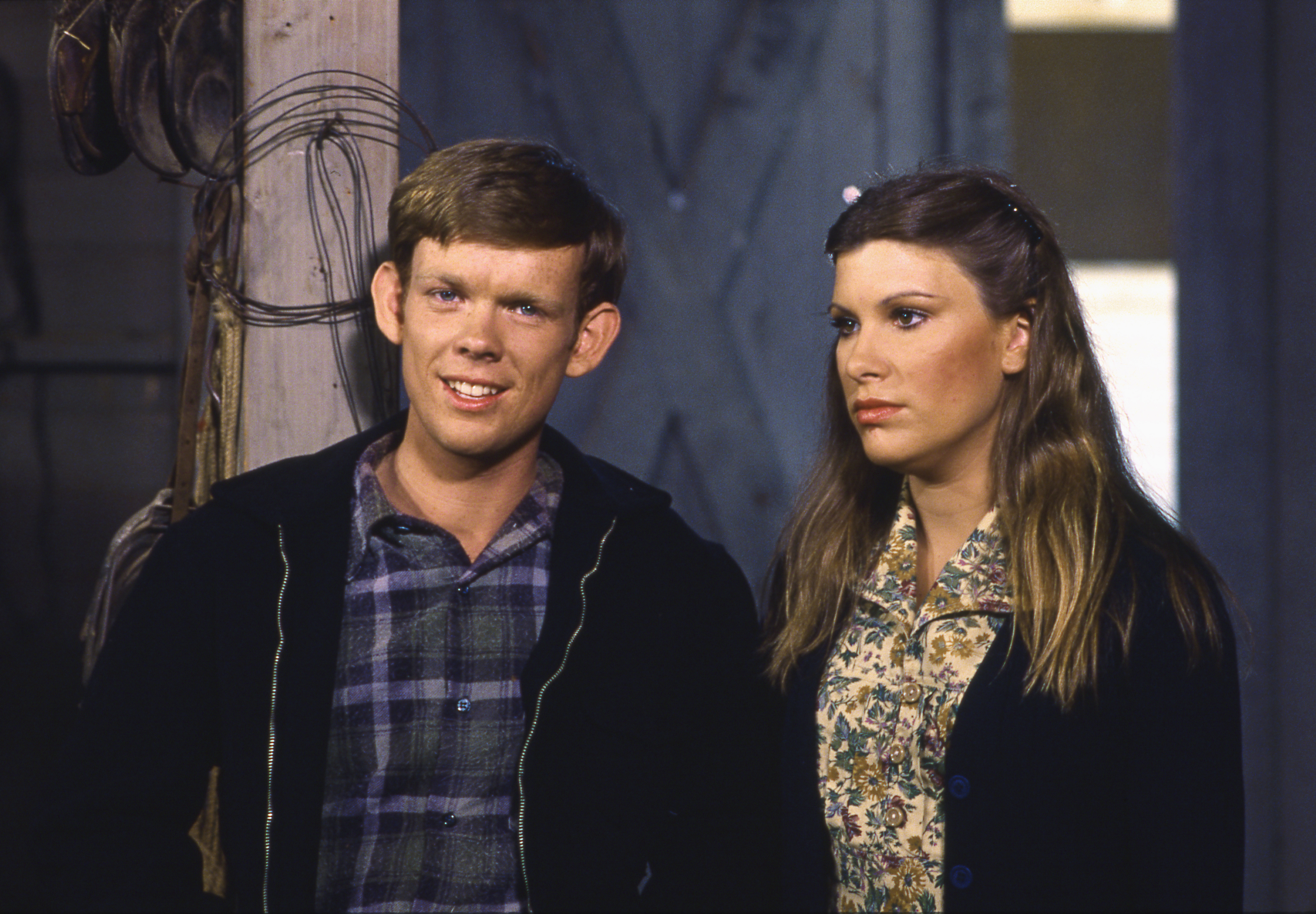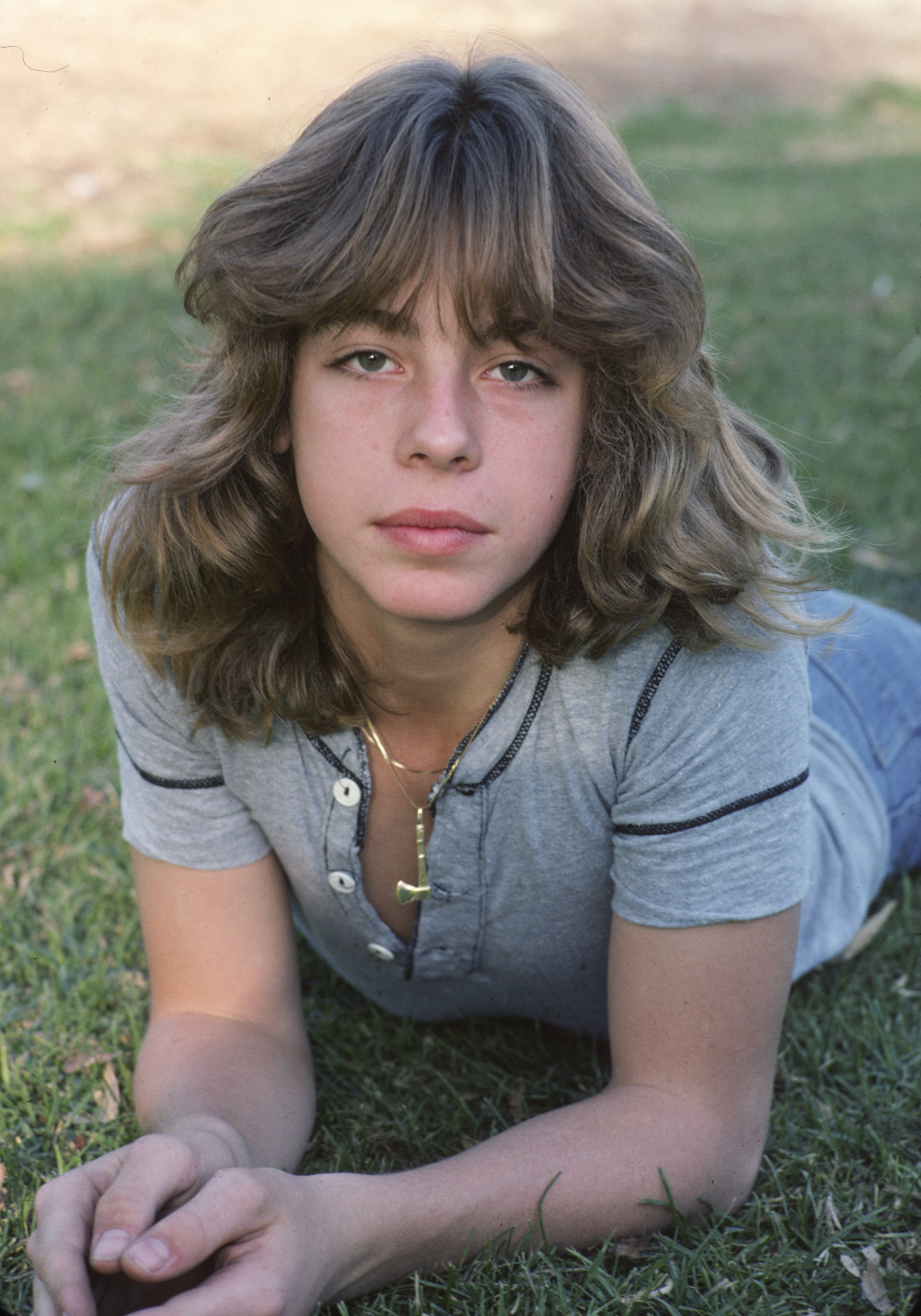Ali MacGraw, Bobby Sherman, and other celebrities are now living completely different lives than the ones they led while in Hollywood. Some of them found their true callings like activism and more. Read on to learn all about what they’re doing now.
John Walmsley’s Life after “The Waltons”
Jon Walmsley was famously known for playing the role of John-Boy’s younger brother, Jason Walton, on the television series “The Waltons,” which premiered in 1972 and ran for nine seasons until 1981.

Jon Walmsley as Jason Walton and Judy Norton Taylor as Mary Ellen Walton on the set of an episode of “The Waltons” on September 20, 1977 | Source: Getty Images
Since October 2019, Walmsley has been living away from the spotlight in Cornwall, Britain, after relocating from California, Living an anonymous life with her wife, Marion, the pair doesn’t have any children.
Walmsley’s parents were originally from Lancashire, Britain. They relocated to California when he was two, and he fell in love with Cornwall during a visit. Speaking about his anonymity in the quiet town, the voice of Christopher Robin for Disney’s “Winnie the Pooh” said:
“I don’t really get recognized as I changed my look a few years ago and now look quite different than on ‘The Waltons.'”
Instead of being upset that people didn’t know who he was, the successful musician shared how being anonymous was an advantage for him because he was a people-watcher. He noted how people tended to act differently around celebrities.
Walmsley said he and his wife loved the coastal path, the woods, the sea, the sheep, the farms, the wild ponies, the cows, and the “good food” where they now live. He explained how they’d gone there for vacations for years and that it started feeling like home.
On his music website, Walmsley recalled how he and his wife had chosen not to go on vacation in 2018 but to move to England in the summer. By June of that year, they’d already sold their car and RV and bid their friends and neighbors in Maine goodbye.
Some of the items Walmsley took with him to England included two parakeets he inherited from his mother, who passed away from Alzheimer’s disease. The actor and Marion started a new life, bought a car, opened a bank account, and registered with the National Health Service.
The couple has since been enjoying the moors, coastal paths, historic churches, and pubs in Cornwall. According to IMDb, Walmsley retired from acting and seemed to be thriving out of the spotlight. In a 2018 Thanksgiving post on Facebook, Marion was photographed kissing her husband on the cheek, with him confessing how “thankful” he was for his wife.
A drastic change in his appearance was also evident—he was gaunter, and his full red hair was replaced by shorter grays. He was also sporting a gray beard and mustache. This was a far cry from his images in February and June 2015, when he looked more like what his fans were used to. Being out of the limelight has been good for Jon Walmsley, who celebrated a big milestone in 2023 – turning 67!
Leif Garrett- The former Teen Heartthrob
Leif Garrett, along with David and Shaun Cassidy and the Bay City Rollers, was one of the names people thought of when it came to ’70s teenage idols. The “I Was Made for Dancin'” singer earned worldwide fans for his boyish looks and pop songs.

Leif Garrett during Music File Photos in the 1970s in Los Angeles | Source: Getty Images
However, in 2023, he saddened fans when they saw his look at age 61. The star was a wholesome act that was inoffensive to his mainly pre-teenage girl fans and their parents, but his adult career was doomed.
In the mid-’80s, his career was pretty much done, although Garrett went back to acting in movies that didn’t gain much traction. Sadly, he was also struggling with substance abuse and the guilt over his involvement in one of his friends, Roland Winkler, becoming paralyzed from a car accident.

Leif Garrett posing for a photo circa 1970 | Source: Getty Images
Over two decades ago, Garrett was drunk and high when he drove off the Hollywood Freeway, leaving Winkler, who died in 2017, paralyzed.
On March 30, 2023, author and actress Ginger Coyote shared a Facebook photo of Garrett and revealed it was what he looked like the last time she saw him. In the image, he looked different while wearing a bandana on his head, a scarf, and a jacket.
One fan responded to the post with a sad word for his appearance, “Aww.” Another person noted how they’d had “such a crush” on the singer for the longest time but that his story tugged at their heartstrings, while someone else could only say:
“OMG.”

Leif Garrett in 1977 at the Music File Photos in Los Angeles, California | Source: Getty Images
On March 20, 2023, another fan shared what looked like an album cover of one of Garrett’s offerings when he was still a big celebrity. The person revealed that they had his pictures on their wall in 1997. Someone else thought what happened to him and Winkler was a “shame,” and the actor became addicted to illegal substances.
The singer once confessed what led to his addiction and downfall, with the details, possibly shocking his fans. During his 2020 interview, Garrett revealed that when he was a teenage idol, his managers lied and said he was sick from exhaustion when they were pushing for his shows to be sold out.
The musician had to feign sickness and was “living this lie.” The goal was for him to come off as having a perfect image of what they wanted from him, but he knew it was wrong. As a young man, he also had a chance to have a musical career, but instead of starting immediately with training, his voice was processed until it barely sounded like him.
A background singer, Jim Haas, was brought in, and the person’s voice was quite prominent, and sometimes Garrett felt like they were making that person’s record and not his. The star felt like they were taking advantage of him for his looks when all he wanted to do was act.

Leif Garrett performs live onstage at The Vogue on July 25, 2015, in Indianapolis, Indiana | Source: Getty Images
He had to sing with plenty of technical help and lip-synced at concerts, which was a “horrible” experience for him. Garrett felt the experience was unfair to his fans who bought tickets to see his live shows.
The star lying about being a musical artist drove him to use illegal substances. The celebrity felt no one wanted to hear what he had to say as long as his records kept selling, and he’d wanted longevity as an adult artist.
However, things have since changed for him, with Leif Garrett saying now he felt good and played music because he loved it. Although, he wasn’t in a rush to do more than that unless it was right and as real as possible.
Bo Derek Lives a Quiet and Private Life with Her Second Husband
Born Mary Cathleen Collins in 1959, Bo Derek admits she just came up with the nickname “Bo” while she was dating director John Derek. The actress was only 16 when the director cast her in his movie, “Fantasies,” which ultimately led to an affair. He was 30 years older than and married to actress Linda Evans at the time.

Bo and John Derek in a black and white photo circa 1981 | Source: Getty Images
However, the director and the actress fell in love while filming in Greece. Bo dropped out of high school to stay in Europe with the director and to avoid statutory rape laws. “The Ten Commandments” star then divorced Evans.
When the “Sunstorm” star turned 18, they moved back to California and remained married from 1976 until he died in 1998. The “Bolero” actor was 71 when he passed away from heart failure at the Marian Medical Center in Santa Maria, California.

Bo Derek and her first husband, John Derek | Source: YouTube/Oprah Winfrey Network
After the success of Bo’s earlier movies, especially “10,” which launched her as an icon, her husband had her appear in several films that did not garner her any significant recognition or success. Five years after the death of her husband, the star met a man who made her fall right back in love: John Corbett.
They were both single when an agent friend of theirs set them up. The longtime couple married in December 2020 after being together for almost two decades. They never made a big announcement of their nuptials, as they’re both known to be very private people.
However, John made an exception while talking to his friend Jerry O’Connell on “The Talk,” where he flashed his wedding ring and said they got married in an intimate celebration. For many years now, they’ve enjoyed a quiet life on their ranch, as both Bo and John are animal lovers.
They have several horses and a vast property they can ride on. The first thing Bo usually does in the morning is ride her horse before embarking on the many chores that come with maintaining a huge ranch. Many of the things inside their home were items from her first husband’s ex-wives, particularly Ursula Andress and Linda Evans.
Most of the pieces were brought in from elsewhere, and she didn’t need to buy much to fill the space. Through the years, Bo has involved herself in many charities. She also started her pet care line called “Bo Derek Pet Care.”
Aside from their main home, they also have a property in Ventura, a little house by the harbor. The “5 Weddings” actress couldn’t help but gush about how fortunate she is to have beautiful homes, horses, and boats, too.
Bo Derek turned 66 in June 2023 and looked as fresh and youthful as she was at the peak of her career. She remains a sex symbol for many people, a term that the actress has gotten used to through the years.
From a Teenage Singing Sensation to a Life Saver, Bobby Sherman’s Journey through Hollywood
Bobby Sherman holds numerous titles: a singer, an actor, and an occasional songwriter. He enjoyed fame as a teen idol in the 1960s and ’70s after releasing a series of successful singles, including 1969’s “Little Woman,” which sold millions.

Former teen idol Bobby Sherman photographed in 1970 | Source: Getty Images
However, besides music, Sherman also became known as the man who sacrificed his career for his children. He took work as an EMT and later became a reserve deputy sheriff. By 1970, besides producing several hit singles, he was also filming “Here Comes the Bride” and “Patridge Family.” He was so busy that he filmed five days weekly and still did evening shows on weekends, with him stating:
“It was so hectic for three years that I didn’t know what home was.”

Pop star and TV actor Bobby Sherman posing for a photo | Source: Getty Images
The concerts and shows were great, but he was so disoriented from working so much that he decided to take a break. He built a studio in his garage and, over the years, recorded scores for television shows. and movies.
In the early 1970s, Sherman was living his best life with a successful career in music and film and two boys he loved dearly. The star had it all, successfully striking a balance between his career and family. Unfortunately, in 1979, his marriage to Patti Carmel ended.

Bobby Sherman as a San Bernardino County deputy sheriff in 2003 | Source: Getty Images
However, he chose to live close to his sons, Christopher and Tyler, to see them often after the divorce. During his sons’ childhood, the “Mr. Success” singer discovered that his now ex-wife was squeamish about blood. The star often nursed his children’s bruised knees and bloody noses and after taking an introductory first aid CPR class, he realized he had a knack for it, recalling:
“Eventually, if I’d be driving down the street and there was an accident, and there was no medical help on hand, I’d get out and, since I usually had some stuff with me, I’d help.”
More training led him to work as an emergency medical technician (EMT) and later added skills in defibrillation. He also started training other EMTs, instructing thousands of police officers in first aid and CPR.
When the Los Angeles Police Department (LAPD) caught wind of what he was doing, they invited him to the force’s training academy. In 1992, he became a sworn police officer with the San Bernardino Sheriff’s Department and the LAPD.
He became the department’s chief medical training officer and in 1999 he was named LAPD’s Reserve Officer of the Year. The singer-turned-actor-turned-EMT thought his job of saving lives was gratifying, yet it was not limited to only patching people up as he also delivered five babies in the field, an experience he described as “tremendously rewarding.”
Despite having a different career, in 1998, after a 25-year absence, fans flocked to see him in concert as part of the “The Teen Idol Tour.” There he appeared alongside Peter Noone and former Monkees TV costars Micky Dolenz and Davy Jones. He had his final show as a solo performer in Lincoln, Rhode Island, on August 25, 2001.
Nine years later, the love bug bit him again, and he married his second wife, Brigitte Poublon, on July 18, 2010, in Las Vegas. With Poublon, Sherman founded the Bobby Sherman Volunteer EMT Foundation, based in Southern California.
Although he chose a different career path, the star remains grateful for the fans who adored him and allowed him the long-reigning title of “teen idol.” The star shared how he chose to give himself a break to do the things he wished:
“Being a teen idol afforded me so many different things in my life. God bless the fans. They made me a teen idol, and I wouldn’t change a thing.”
After many years of changing his career, Sherman still receives hundreds of fan letters. The “Happiness Is” singer, who turned 80 in July 2023, enjoys a quiet life with his wife and often looks forward to visits from his two sons and six grandchildren.
Ali Macgraw Gave up Hollywood for a Quiet Life in Mexico
Ali MacGraw will always be remembered as a great actress of beautiful, intelligent, and had great style. However, it’s not just her on-screen performances that have left a lasting impression—her romantic relationships have also made waves in the entertainment industry.

Steve McQueen and Ali MacGraw in a scene from the 1972 movie “The Getaway” | Source: Getty Images
Throughout her illustrious career, the talented performer married three times. Her first union was with Robin Hoen, followed by marriage to the esteemed producer Robert Evans. Finally, she said “I do” to her “The Getaway” co-star Steve McQueen.
When MacGraw married Steve McQueen, he forced her to give up her acting career because he wanted to live a “normal life” after having had a difficult childhood. The actress recalled:
“At the time, he was the biggest movie star in the world, and he didn’t want me to work, so I essentially quit making movies and took care of my child [Josh].”

Robert Evans and Ali MacGraw at the premiere of “Ryan’s Daughter” on November 9, 1970, in New York City | Source: Getty Images
According to biographer Marc Eliot, McQueen’s infidelity and substance abuse, which contributed to his reputation as the industry’s “bad boy,” greatly affected his marriage with MacGraw. In the end, the actress and McQueen ultimately called it quits in 1977.
After going through several failed marriages, she felt the need to focus on establishing a stable home for herself when choosing to retire at the peak of one’s career. However, she did not give much thought to this idea in the past.

Ali MacGraw tickles her son, Josh Evans, in California in 1978 | Source: Getty Images
According to MacGraw, she never accepted divorce settlement money because she believed it was the right thing to do. This choice, however, left her nearly penniless. She reportedly admitted:
“I had a romantic, ‘Aren’t I a good girl?’ take on divorce, but the truth is that was stupid.”

Ali MacGraw and her son Josh Evans on March 6, 1992 | Source: Getty Images
Ali MacGraw left Hollywood because she faced financial difficulties due to her past marriages. She decided to start over by moving to Santa Fe, New Mexico, leading a low-key, uncomplicated life there. After her Malibu home in California was destroyed by fire in 1993, she relocated to Santa Fe in 1994.
she lives in a charming little cottage, where she enjoys reading and collecting rocks. MacGraw found that spending time alone was fulfilling, and she did not see herself as the typical woman who would submit to her partner’s every desire.

Ali MacGraw works as a volunteer at the annual International Folk Art Market on July 13, 2014, in Santa Fe, New Mexico | Source: Getty Images
In January 2023, MacGraw was 83 years old, had been single for 44 years, and is a proud mother and grandmother. She has retired from acting and has no plans to return to the spotlight. The veteran star also admitted that she has not been earning a consistent income recently but thinks she has become “much more famous” than being wealthy.
Although she may not have much money to give, MacGraw loves to use her voice when asked to support causes she cares about, such as animal welfare and the environment. She previously helped a conservation group in Vietnam called Animal Asia, whose causes centered around bear preservation in the said country.

Ali MacGraw at Hearst Magazines’ Unbound Access MagFront on October 17, 2017, in New York City | Source: Getty Images
The former actress even flew to the country to assist them in keeping the sanctuary open rather than closing it. MacGraw has stayed busy because she lives in a small town where many groups need help. She said Santa Fe is a community that cares about animals, and she volunteers and supports the group named Animal Protection New Mexico.
The former star is proud to be part of her little community’s “world-class organization” because the group has ensured that domestic and wild animals will always be safe, protected, and cared for. Her daily routine is to get up at 5:30 in the morning, feed her animals, walk, garden, paint, and volunteer.

Ali MacGraw at Animals Asia: Kindness in Action on March 5, 2020, in Los Angeles, California | Source: Getty Images
Determined to be healthy, she has attended yoga or Pilates classes. She also walks every day as a form of meditation and has a 45-minute session of self-reflection on gratitude. MacGraw feels incredibly fortunate to have them in her life.
In addition to meditating, she maintains contact with a small group of close friends and frequently goes on dates. MacGraw cherishes her time with her only son, Josh, who is now a thriving author, screenwriter, and filmmaker.
Josh is now a father to a son named Jackson and his famous mother is a proud parent and grandmother who has realized that being a parent is one of the “hardest of jobs” yet the most fulfilling in the world. Overall, MacGraw has found peace and contentment in her simple and quiet life in Santa Fe. She’s focused on living in the present, cherishing her time with her close friends and family.





























































































































































